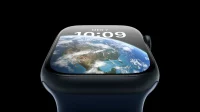Apple has reportedly made a major breakthrough in non-invasive blood glucose monitoring on the Apple Watch. His system is currently the size of an iPhone.
Apple has been working on integrating blood glucose tracking into its Apple Watch for a long time. It seems that today the apple brand has taken a big step forward. According to Bloomberg, its non-invasive tracking system is now in its “proof of concept”stage, and this module could enter the market after further miniaturization. The technology, which uses lasers to measure blood glucose levels under the skin, was originally the size of a small table. The current prototype is now the size of an iPhone.
Apple has reportedly made a major breakthrough in non-invasive blood glucose monitoring on the Apple Watch.
This system will not only allow people with diabetes to monitor their disease on a daily basis, but will also serve to alert people with prediabetes. The latter can then make changes to minimize the risk of type 2 diabetes.
As always, Apple did not comment on the information. According to rumors, this project has been in development for a very long time. This was to start in 2010, when Steve Jobs acquired blood sugar monitoring startup RareLight. Apple kept the project under wraps, carefully isolating operations into a separate company, Avolonte Health, before merging them into the Design Research Group (XDG). CEO Tim Cook, Apple Watch CEO Eugene Kim, and other senior officials were involved.
His system is currently the size of an iPhone.
As interesting as this achievement is, we shouldn’t wait for such a module to appear in the Apple Watch for several years, Bloomberg continues to report. The industry also unfortunately already has several setbacks regarding this type of sensor. In 2018, Verily, the healthcare subsidiary of Alphabet, dropped plans for smart contact lenses that included tear glucose monitoring. Even large companies with significant resources can fail, and at this stage no one knows the level of accuracy of Apple’s solution.
However, there are many benefits to using such technologies in wearable accessories. The Apple Watch is heavily touted as a health tracker and can already detect signs of atrial fibrillation, low blood oxygen, and even ovulation cycles (for the Series 8). Non-invasive blood sugar monitoring could make this smartwatch indispensable for diabetics, who then no longer need a special device, which most often includes a blood draw needle. This painless approach will give the Apple Watch a distinct edge over the competition.


